- This feature was published in RAIL 771.
It was an unusual situation in which Serco found itself. When the company was awarded the Caledonian Sleeper franchise last year, it was intended that ownership would transfer at 0200 on April 1 2015. That’s the time most operators change hands, but that would prove difficult for the Sleeper - that’s the time its trains are running.
Peter Strachan, Caledonian Sleeper Managing Director, explains: “We said to Transport Scotland and to First: ‘why don’t we change on March 31, rather than April 1?’
“So what’s actually happening is we hand over at 1400 on March 31. Every positioning, every train, every movement, every staff member booking on for the evening services of the Caledonian Sleeper. Which I think is a much more sensible suggestion. That was our suggestion. We thought about it when we were doing immobilisation.”
This franchise is a first. It will be the first time the Anglo-Scottish Sleepers have been operated away from the main ScotRail franchise, and indeed the first time any Sleeper trains have formed their own franchise (the UK has only the Caledonian Sleepers and the First Great Western London Paddington-Penzance trains).
Says Strachan: “I don’t think it’s a risk. I think it’s a very sensible decision from Transport Scotland’s point of view, to split it over the main franchise. If I think back to my InterCity days, in any ownership of either British Rail or subsequent franchise, the Sleeper has always been one of 2% of the rest of the activity.”
(When the deal was awarded on May 28 2014, operator FirstGroup - until March 30 - said: “The Sleeper services, which currently operate four cross-border trains per night, constitute 2% of First ScotRail’s total annual revenue.”)
Strachan clearly thinks the Sleepers have been neglected, but not through direct choice: “I think, talking with staff as we have been doing, everybody has said it’s really good to see a lot of management attention. Meeting people, a dedicated focus, I think people will value that.”
More than 90 staff are transferring from the ScotRail franchise, but there are also vacancies. In terms of staff numbers, the Caledonain Sleeper franchise is not very big, but in terms of passenger miles it is huge.
“Think about the term lengths of some of the on-train team. If you work a ‘Highlander’ on the Fort William leg - you’re booking on, you’re leaving Euston at 2115, and you’re into Fort William not much before 1000.”
The attitude of staff has impressed Strachan: “I’ve been massively impressed with the dedication, the commitment and welcome that they give people. I said to some colleagues this week, I’ve done lots of transitions and emergencies, and I can’t think of a team that’s been more engaged in relations than people we’ve had this week. We’re really, really, really strong.
“Some of the things we’ve been doing are quite different. We’ve started talking about new rolling stock - they’re excited about that. We’ve been taking them through the new menu, the new food and drink offer, the new uniforms. And people have been going ‘this is really good’. There’s passion there anyway, there’s that dedication, and they really want to get going.”
Serco has made the decision to be based in Inverness. Strachan elaborates: “We wanted to break the mould of Glasgow. I think traditionally in Scotland, the railway has been central in Buchanan House forever.”
He says that moving to the Highlands sends a message. Some of his team, including former Network Rail Route Managing Director David Simpson, who is now Production Team Director, will be based there “because that’s where the relationships will have to be”. But his reasoning for Inverness is also: “We thought that the Sleeper is Scottish, what better place than the capital of the Highlands to have it?”
He admits to being surprised at the response: “I thought it’d be quite difficult to try and go to Inverness, but actually the reverse is true. We said to respective candidates that the job is in Inverness, and they’ve thought that’s good, that’s really good.
“When we put the advert out, we weren’t sure what we were going to get in Inverness. But I’m really, really pleased that we’ve got really good people.”
What about the markets - which is the biggest?
Certainly in the summer, that’s Fort William. Says Strachan: “We run four or five in the summer months, but we find the loadings are historically very strong, and since we opened the new website at the beginning of January, Fort William has been particularly strong. Inverness has also been strong. The one we want to have a look at is Aberdeen - it doesn’t seem to have performed, historically, as strongly as Fort William and Inverness.”
Strachan says Serco is therefore investigating issues surrounding Aberdeen. “It is a very spectacular run. You’ve got Forth Bridge, you’ve got Tay Bridge, the Montrose Basin is an interesting bit of geography, and (on the way) Leuchars for St Andrews. If you like golf, there’s Carnoustie. And I think Dundee is up-and-coming. The redevelopment of the waterfront… I think Dundee will be a great destination.”
Aberdeen is traditionally about the oil industry. Is that the market for the trains? Do they even serve the right area?
“One of the bits of work we’re doing at the moment is trying to understand what the Aberdeen market is doing. You can surmise that given the challenges in the oil-gas sector, that currently the general business travel market may well be depressed. We’ve seen some signs of that. But I want to work with the team and with agencies who will visit Aberdeen, just to understand a bit more.”
A lot of businesses related to that industry are based in Dyce, half a dozen miles north of Aberdeen. Is it worth extending the CS trains there?
“Possibly,” replies Strachan. “Oil flies, it has to fly to get on and off the rigs, and it struck me the last time I was at Dyce - it’s relatively straightforward to get to the Dyce-Bristol helicopter to Dyce Airport and then make that connection to go elsewhere. To get back into the city by train and think about the Sleeper, it might just be too much of a challenge, the way it is at the moment. So I want to understand what is motivating people to do things.”
It’s not just destinations within Scotland that Strachan has been considering. He was at Holyrood on March 10, talking to the cross-party rail group chaired by MSP John Mason, and was asked about new destinations for the Sleepers.
“This is a franchise, this is not an open access operation. We have convinced the Scottish government to co-operate with what we’re operating. But we should always, strategically, have a look.
“If I think back to previous work that’s been done, the West Midlands is an interesting proposition. The challenge proposed to the West Midlands is: can you depart and arrive in both directions at a time that is sensible, and still do what you want to do from a Euston point of view? I think some of us are old enough to remember South West to Scotland trains.”
Could they make a comeback?
“Interestingly, Brian Soutar and Martin Griffiths, who are extremely shrewd businessmen, are just pulling Megabus overnight off Cardiff and Scotland, which I thought was quite interesting because there was quite a strong Scottish-Wales link. But if Brian and Martin reckon they can’t make money off South Wales to Scotland, I’d be hesitating to beat them to their word.”
What is the competition for the Sleepers?
“What we have to remember with the Sleeper is… it’s a journey, but it’s overnight. So probably going head-to-head with either air or daytime services is only one bit of the argument. What we’re competing against is people who fly and stay overnight, or do the reverse. Hence why we’re trying to transform it into more of a hospitality thing.”
When Serco won the CS deal, it said that the franchise would offer “an outstanding hospitality service”. What does the company mean by that?
“If you benchmark the best of the welcome, the best food and drink, and translate that onto a service that not only gives you that but also takes you from Scotland or vice versa, that’s what we’re looking for.”
And it’s not just the holidaymaker market that CS is after. Says Strachan: “From a business travel point of view, I think that the business travel market is ever more discerning and less tolerant than people might have been even ten or 15 years ago.”
Nor does he want passengers to think CS is about only the luxury end. “We are still very interested in the overnight market. There’s definitely a market there - with an entry price of just over £23, that’s highly competitive with anything else, and a new train. I think there is a diverse market there that you should ignore at your peril. Let’s not just push it all the way through to the luxury.”
There was some controversy regarding Serco’s CS website that launched in January. This was the first time a new franchise had begun booking tickets before it began operating trains, but there were complaints regarding purchasing supplements and what’s actually available (The Fare Dealer, RAIL 770). Reportedly, the Association of Train Operating Companies has intervened.
Strachan explains: “This was a clear requirement from Transport Scotland, which was around creating excitement and making sure that we didn’t have a booking gap. Because you can just imagine what that would have been like - First running it up to March 31 and we take over on April 1, one website goes off and one website comes on. I think that would be quite challenging, as this is not a normal franchise transition. Also, one of our key commitments was to offer 12-month advance booking, which has never been done before, apart from during the Olympics.”
On this last point, Strachan believes that this is absolutely the right thing to do.
“Particularly the leisure market, and events-driven, people are making their travel choices a long time in advance. If you are going head-to-head with the airlines, not being able to offer something beyond the three-month horizon, you’re already disappointed.”
But are people buying tickets?
“Gosh, yes. It’s very interesting. One of our group board members said: ‘are the bookings in line with expectations?’ I don’t know, because we’ve never done this before, we’ve never put a 12-month booking window out there. We can see what’s happening, but as soon as we launched it we got really strong take-up.”
What about ATOC concerns?
Strachan replies: “They’ve not put those to us directly, if that’s the case.”
He admits that there have been problems, but adds: “By and large, 95% of the feedback we’ve had is very strong. People say they can’t fall into the trap (as they do at the moment) of booking something, and they think they’ve booked a berth when they’ve actually booked a seat - it’s really clear. And the thing we’ve just introduced - we can move your berth, we opened up that last week. It’s like theatre-style booking, so you pick your seat and you can pick your berth.”
There are several markets for the Sleepers, depending on your destination.
“In the traditional split of business and leisure, it’s actually about half and half. Business is slightly stronger in Glasgow and Edinburgh, as it is to Fort William and Inverness. We’re seeing quite a strong business growth in the Inverness market, reflected (I think) with Inverness growing as the Highland capital.
“But journey purpose is incredibly diverse, all the way through from weekly commuting. We get a lot of that. We get a lot of the leisure people do it for the weekend away - so down on the Friday, back on the Sunday night.”
As for which direction is busier (north-south or south-north), Strachan says it depends on the time of year.
“You get the type of flow peaks you would expect. For example, on May 22 before the Spring Bank Holiday, I could probably sell four trains on each of them. The demand is high. But again, things like Maundy Thursday and then all the long-distance services, you’ll find Sunday nights are always busy.”
The Caledonian Sleeper does seem to be focused on north of the border a lot of the time. Strachan, himself a Scot, acknowledges that can appear to be the case: “I think even though we want to create an essentially Scottish business, and it’s a Scottish government-sponsored contract, we forget London and the South East.”
He admits that it has “probably been the case” that London is seen merely as a starting point for the trains, and no more. “We want to ensure that with the Caledonian Sleeper, it is Scottish but that London is part of it. Alan Moore, who’s our uniform designer, really did that. When he designed our new tartan, because we have a Caledonian Sleeper registered tartan for the new uniform and interior design, Alan brought colours into it that were representative of the St George’s Cross. We’ve got red and white with it. We recognised that we didn’t want to push the thing to be so Scottish that it wasn’t appealing to London and the South East.
“As a Scot I’m furiously proud and loyal, but not to the extent that we should be blinkered about the communities that we serve in the South.”
Another change could be the use of lounges (which will continue), and the possibility of early boarding. More sittings for food could also be possible.
“We are trying to get early board. It’s great to have the lounge there, but I would like if we can on Highland to be out on the platform and to have doors open by about 1930.
“That’s ambitious, given what else is going on at Euston at that time of night, but it means we can welcome people on board, they can get settled in, and they can get into the lounge car.
“The problem currently with the lounge car, particularly on the Highland, is that everybody wants to eat as soon as they’re on. So we’re platformed and open at around 2030 at the moment, and everybody wants to eat. By bringing that an hour earlier, we could effectively have a couple of sittings. And part of the moving of the website and the app of the virtual concierge allows First Class guests to reserve a table in the lounge.”
There are also issues surrounding Euston, which is set for redevelopment for its role as HS2’s terminus. This means that other termini are being investigated.
“We’re looking at options,” says Strachan. “The option I like best is get into King’s Cross/St Pancras. We know King’s Cross cannot currently accommodate 16 carriages, but we know St Pancras can. I would like to go to the international platforms, but I would not like to go to the international check-in and immigrations!”
There’s also the benefit that whereas King’s Cross would need to be extended to fit the CS trains, St Pancras would not: “You can accommodate a 16-car train. What we would have to make sure was that we can find a route, a way out from there.”
The big headline from the new deal was the rolling stock and traction - rebuilt Class 73/9s and overhauled GB Railfreight Class 92s supplied in a 15-year deal worth £100 million. This replaces the current DB Schenker offering of Class 90s on the West Coast Main Line and Class 67s north of the Central Belt.
Strachan explains: “GBRf has a reputation as an innovative, can-do organisation. I think that’s about leadership, and John is well-known and well understood in the industry for getting it done, which in a business like ours is exactly what we needed.
“GB was prepared to innovate in terms of traction, which is good because the ‘92’ gives us more than the ‘90’, and I think that the whole ‘73/9’ thing is hugely innovative. I’m genuinely excited, because on the face of it, you go ‘oh my goodness, what are they doing?’”
Even Strachan seems slightly taken aback by the thought of these rebuilt 50-year-old Southern Region electro-diesels working in the Highlands: “You’ve got kind of suspended belief, haven’t you?”
However, there have been teething problems, and so ‘67s’ will remain until the autumn. Class 47s had been proposed by GBRf, but a deal has been struck meaning that Class 67s will remain.
Adds Strachan: “The other thing, to ‘big John up’, is his whole team have been really passionate about driving confidence for the Sleeper. It’s a different technique driving a Sleeper. It’s a bit of a dying art, and GBRf was really very keen.”
The principal element is the new carriages. They’ve not officially been given a classification yet, but perhaps they could be labelled Mk 5s?
“I’m glad you’ve called them that,” says Strachan. “Because I said that to somebody the other day, and they said ‘yeah, I suppose you’re right’.”
The new carriages will be built by CAF in Spain, with the first entering traffic in 2018. These are the first locomotive-hauled carriages to be built for the UK market since the Mk 4s were introduced onto the East Coast Main Line in 1989-1992. But the ‘Mk 5s’ will be much different.
Strachan explains: “It would have been a huge temptation to say ‘let’s build a luxury train’. What we have contracted to do is this: the vehicles have a proper reclining seat. So something better than premium economy on British Airways and Qantas - a bit of a reclining pitch, and a hugely more comfortable seat than we have currently in the Mk 2s.
“The thing that really excites me is that the pod will be akin to a business class airline. One of the things that we agreed with CAF is to test the wider transport market. To my reckoning, there’s currently only one of these in the world, and that’s in Queensland. So we’ve been really clear and keen with CAF to say ‘let’s test these’. We’ve agreed with CAF in the design process that we’re going to test what the market can give us.”
Strachan recognises that the length of the journey from the Highlands means that the train is effectively the same as a long-haul flight. “It’s like going to Johannesburg or Vancouver.”
That means the Mk 5s must be different: “Something that says this is a railway, but different. It’s not a railway per se. And I think the pod will be hugely attractive and very flexible.
“We’ll then have a standard berth, which is keeping with the configuration of either being a twin or a solo. And we will have a flexibility to do that, so it gets rid of the idea that you’ll still be sharing with a stranger in 2018. If you want to bring somebody to share with and you’re both happy about it, that’s fine. But we’re not going to force you.
“And a couple of types are in the design programme of premium berth: en-suite, which I think again is a hugely attractive proposition; and en-suite with a shower. We will also have in that vehicle (and possibly another vehicle) some other showers.”
He says decisions regarding who can use the showers have yet to be made. “But we will have showers that are in the general area - not just allied with a bed.”
With all this equipment on the Mk 5s, surely they will be heavy?
“We believe they will be a bit lighter than the Mk 3s. It’s an aluminium body shell, and modern materials tend to be a lot lighter than the materials we knocked out at Derby in the late 1970s.”
Currently the Mk 5s are at the design phase, with Interfleet appointed as the project integrator.
“CAF has started the design process. We’ve had kick-start meetings both in the UK and in Spain, and Ian Smith has been introduced to the CAF team to start thinking about the interior design of the trains. So we’re off and going.”
It will necessitate a quick turnaround, but Strachan doesn’t seem fazed: “I’m not unhappy about the design and the construction programme. The signing on February 6, trains in service from April 2018. I think that’s long enough - not too long to be silly, but long enough for us to actually get it done.”
He says that the first vehicles will arrive in the UK in the first quarter of 2017, and that ideally they will be commissioned at Old Dalby.
“We’d like to get in there, because it is ours! I’m not sure if we can book our own slot there. You have to make sure that we’re treated properly as a customer - as a supplier and vice versa.
“So that’s one of the details that the team has to carry out… what is the commission plan? We’re going to use the main commissioning because, as part of the new train’s deal, we signed Alstom up to be the maintenance team. I think that’s really good - I really like the continuity between Mk 2s and Mk 3s and the Mk 5s, from an Alstom point of view.”
For trains running north of the border, the weather remains a factor that must always be taken into consideration.
Says Strachan: “I think from a train performance point of view, it is a contingency arrangement for Scotland during the winter. Because it strikes me that it is not plausible from a messaging and a guest point to say that ‘it’s cancelled tonight because of bad weather and we’re going to put you on a bus to see you across to Perth’. That doesn’t quite add up in my view.
“There would be no such thing in the North as the all-weather railway. But I would like to think that between ourselves, the Network Rail team and the Abellio team, we would do everything to keep the thing moving. Because if the Sleeper can’t get through, that should be the benchmark.”
Earlier this year the Rail Delivery Group published a report that discussed how the railway responds to poor weather, including proving runs to ensure the line is clear.
“The first Down train in Aberdeen is slightly different, but certainly in the Highland and Fort William we are the first train,” says Strachan.
“I started having a dialogue with Network Rail colleagues, but it’s just how to make sure we run the Sleeper at every possible opportunity. People rely on it. It’s really telling. We saw that in some of the numbers we had coming through on a Friday night when Glasgow Airport was completely snowbound back in the middle of January. We saw quite a lot of walk-up business on the Glasgow Sleeper line, because of people being kicked off various FlyBe’s and things.”
In the event of line closures, the Mk 5s will also be gauge cleared for the Settle-Carlisle Line, for the Glasgow & South Western via Dumfries, and for the East Coast Main Line.
“If you can run the train, you want to run it. Talking to people, it was this feeling that it would be so much better if you get the train, to keep it open. You don’t want to be disrupted.”
Abellio takes over the ScotRail franchise in April. What’s the relationship like with Serco’s Caledonian Sleeper?
“Because of our relationship on both Merseyrail and Northern - strong working relationships - we kind of need each other. They will be supplying the train managers for the Highland sections, which I think is a smart thing to do because that’s where the knowledge is. They’re supplying level 5 at Inverness, so keeping it at Level 5, and obviously the station access of all the principal places around Aberdeen.”
Another thing that Serco will introduce is passenger help. Totems will be introduced.
“It will provide WiFi, for stations that don’t have WiFi. It will provide interactive information, so train running information for the Sleeper. But you’ll also be able to talk to the guest services centre.”
Strachan was based in Australia before he took on this role. Why make the move back?
“Why not? I’m a Scot. It’s genuinely exciting. I can’t think in my career (35 years this year) that I’ve had the opportunity to transform something that’s been a bit stagnant, a bit tired around the edges, with an absolutely brand new fleet and a proposition that takes it to a completely new era.
“I know it’s warm and sunny in Sydney, my wife says when she sees the snow from the car at Aviemore, but if you get offered that sort of thing then what’ll we do? It’s the absolute opportunity just to do something very, very, very different. A great opportunity.”
Until the new stock arrives…
Until the CAF-built stock enters traffic in 2018, Caledonian Sleeper trains will be formed of the Mk 2 and Mk 3 carriages that are currently used.
Managing Director Peter Strachan tells RAIL: “I was talking to a customer in the lounge, on his first time on a Sleeper. He said to me ‘how old are these?’ I told him, and then said ‘but the Sleeper cars are a bit younger’. He said ‘what do you mean?’ and I said ‘they were 1979-82’!”
Strachan says there are two things on which CS constantly gets feedback: “One is ‘I can’t plug in my device’, and a lot of us carry more than one. We’ll have an iPad or we’ll have a laptop, or a phone, and they’re all very hungry. That’s something we want to try and do as early as we can, even with the existing rolling stock.”
He says that there are various ways of resolving that issue. It can be done by portable device, and CS is continuing to investigate whether it can covert the shaver socket.
Says Strachan: “I understand, although I have never done it, that people carry adapters to plug things into. But obviously, my nervousness would be, given the surges you get in the electric sections, that the last thing I want to be presiding over is people with zapped iPods and zapped phones. That would cost a lot of money. So we want to find a way of doing it that’s surge-protected.”
The second issue for feedback is showers… or rather, the lack of them. Says Strachan: “We can’t do anything about that until 2018, but what we are doing is partnering with destinations that have a shower. The two places where we already have agreements - we have an agreement with a hotel in Crianlarich and one in Aviemore. That’s the kind of model we want to try and roll out. In Glasgow we have showers, in Euston we have showers, Aberdeen and Edinburgh we have showers. But progressively we will be looking at that as an opportunity.”
The romanticism of the Sleeper
There is something romantic about the Caledonian Sleeper - leaving the rat race of London and waking up in the quieter, more peaceful and relaxed Highlands, or the bustling cities of Edinburgh and Glasgow.
Caledonian Sleeper Managing Director Peter Strachan understands that completely… and wants to tap into it.
“One of the things that we’re offering is the themed evenings. So we’ll have four or five or six themed evenings a year, ranging from readings of Scottish literature to whisky tasting to things from the Edinburgh Fringe festival, to bring out that sort of greater romanticism.
“I find nothing better than sitting in the lounge car across from the moor, when the sun is starting to come up. Last week, I wasn’t quite at Perth. A bit north, sat in the lounge car, snow on the ground, and there’s deer running around. I was looking at it mesmerised, thinking ‘I get paid for doing this!’ We have to bottle that, capture it and sell that as part of it.”
There will be immediate changes.
“From day one, a completely new menu. We spent a lot of time constructing this menu with a food partner, a firm called RSF, so virtually everything we have on board from a meal point of view is from Dingwall.
“So what we want to do is explain the providence. We can’t quite tell the name of the sheep that was in the lamb, but it’s nearly like that. We’re also working with Food and Drink Hub Scotland, who are based in Cumbernauld, run by Paul Anderson and his team there. They have a great reach into Scottish small-medium enterprises of food and drink production, and they’re our aggregator. We’ve deliberately set out to partner with small Scottish businesses to bring that feeling of Scotland - the taste of Scotland. The wine list is being revised, too, and there will be whisky.
“One of the things that we want to do, both from a whisky and a beer point of view, with the number of craft breweries that there now are in Scotland, we want to bring that onto the train, but also rotate it, so that we could have a malt of the month or a beer of the month.”
Food will change. Says Strachan of a recent trip: “I ordered the cooked breakfast. Even the labelling of the food as it’s supplied says ‘meat breakfast’, and it just doesn’t say quality.
“So we have completely changed the breakfast. We’re going to offer porridge, we’re offering smoked salmon and scrambled eggs, which always goes well, and a full Highland breakfast. Bacon roll, and for the lighter taste, granola and wholegrain toast, everything like it. Guests will have the opportunity to pre-select that, for First Class. Standard guests can buy.”
There are challenges with the rolling stock, surrounding the preparation of food, with technology dating from the late 1960s.
“Of course, we have a challenge in the existing vehicle, - we have two microwaves and a pantry. Before we agreed with RSF what the menu would be, we tested it. Buying a microwave that was the same as the microwaves on board, and deliberately downgrading its part to represent what you get. Just to make sure that the stuff that RSF was doing you could do it in a microwave, and you could plate it up and present it in a decent manner.”
Class 73/9s
How will the rebuilt Class 73/9 electro-diesels be used on the Sleepers?
Caledonian Sleeper Managing Director Peter Strachan explains: “On Fort William and on Aberdeen they won’t be pairs. But we’re going to start off with a pair on the Highland , because until we know what they’re going to do, particularly Slochd in the winter, I would be careful.”
Strachan says the West Highland Line to Fort William does not present a problem, because it’s a shorter train.
“We’ll have to pass this group double-heading on Inverness for testing. Inverness will be the first test - we haven’t decided how we’re going to diagram them yet. Ourselves and GB Railfreight have said: test with the existing fleet, test after the winter on double-heading - because summer and winter is very different in that part of the world, very different.
“And then obviously test a few rolling stock, so that we’re really sure, because I don’t think we want to double-head unless we need to.”
The stock will be painted in midnight teal.
WiFi on new stock
Technology moves at a fast pace, and so by 2018 there is every chance that current WiFi technology could be outdated. How would that affect the Mk 5s?
Caledonian Sleeper Managing Director Peter Strachan explains: “This was the debate we had in Sydney, where we were saying that Government specify at least 4G connectivity on North West railway. The bidders were saying ‘by the time this thing’s built, there’ll be into 5G if not 6G’.
“I think we just have to keep pace with whatever it is. Maybe the connectivity has moved for the majority of the country, but just remember where we are. World connectivity has moved to such an extent that even if you’re further North or on the West Highlands, you’re still going to get something.
“I think the spec we’re looking at with CAF is much more akin to a full-blown entertainment system that you would find in a plane, with guests able to select a whole bunch of things - films, music, all that kind of stuff.
But it’s three years on, and we just have to think about that.
“There is no doubt, the fact that we don’t have any WiFi capability on the current Sleeper is another source of irritation. You see people sitting in the lounge car, going ‘oh, I’m just going to send a couple of emails’.”
Branding
The new livery for CS trains is midnight teal. Managing Director Peter Strachan says: “You can see it in some light and it looks very near BR blue.
“I remember a long, long time ago opening a little tin of Humbrol BR blue, and we’d had a huge model railway, an absolutely huge model. And my Dad was painting a BG, and it was very dark. And midnight teal - it’s not quite blue, but it’s in that spectrum.
“I happen to see that green tinge in it, just in certain lights, so there’s a bit of mystique about it. So midnight teal, all of them will be in midnight teal, and ‘67s’ will be in midnight teal for the period of six months.
“If you think about it, the first thing you see on the stops at Glasgow Central or on the stops at Euston is the locomotives, so even the ECS ‘86s’ from Wembley are going to be in midnight teal.”
- To read about the first Mk 5s arriving in the UK, see RAIL 845, published digitally today (January 27), and on the shelves on January 31.

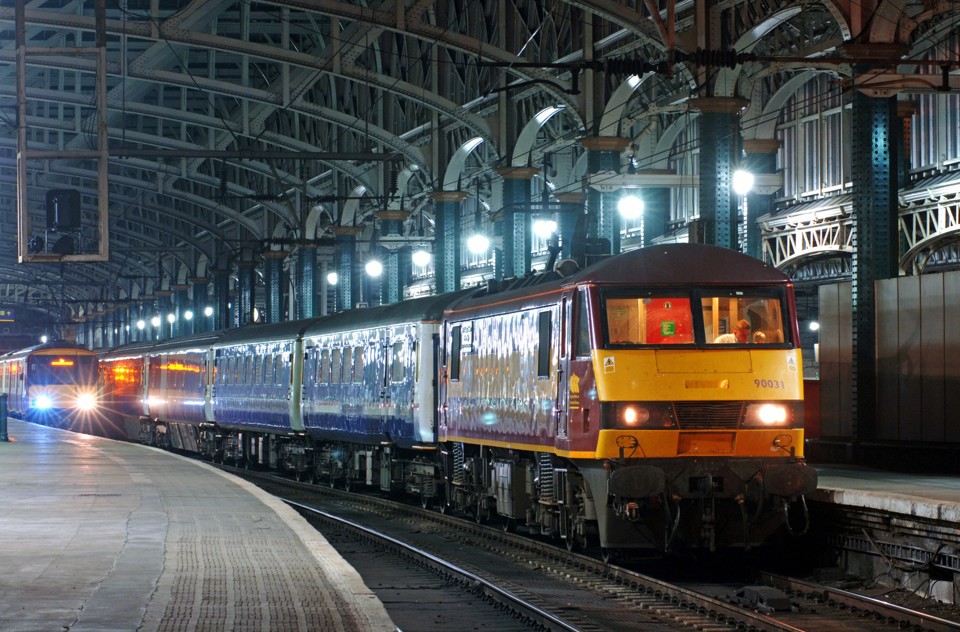



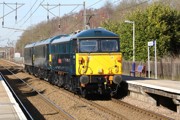
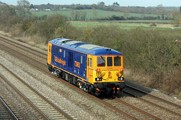
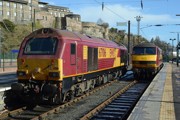
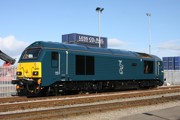
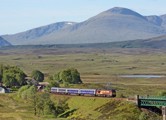

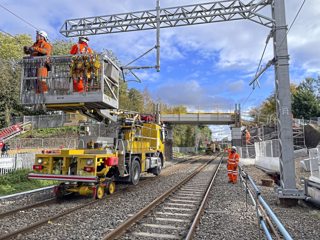
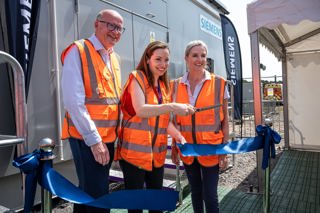
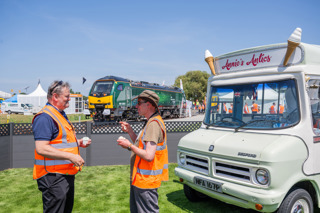
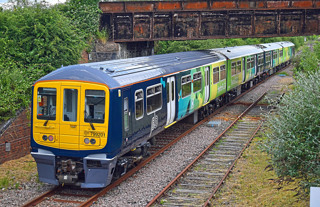











AndrewJGwilt1989 - 27/01/2018 22:22
The new Mk5 carriages (coaches) will feature free wifi, disabled & standard toilets, catering area, buffet area, beds, seats, First Class area, quiet zone area, lights, information display screens and automatic plug doors with buttons without having to open and close the door manually. Similar features with the Mk5A’s carriages that are to be built for TPE for rural Transpennine routes.